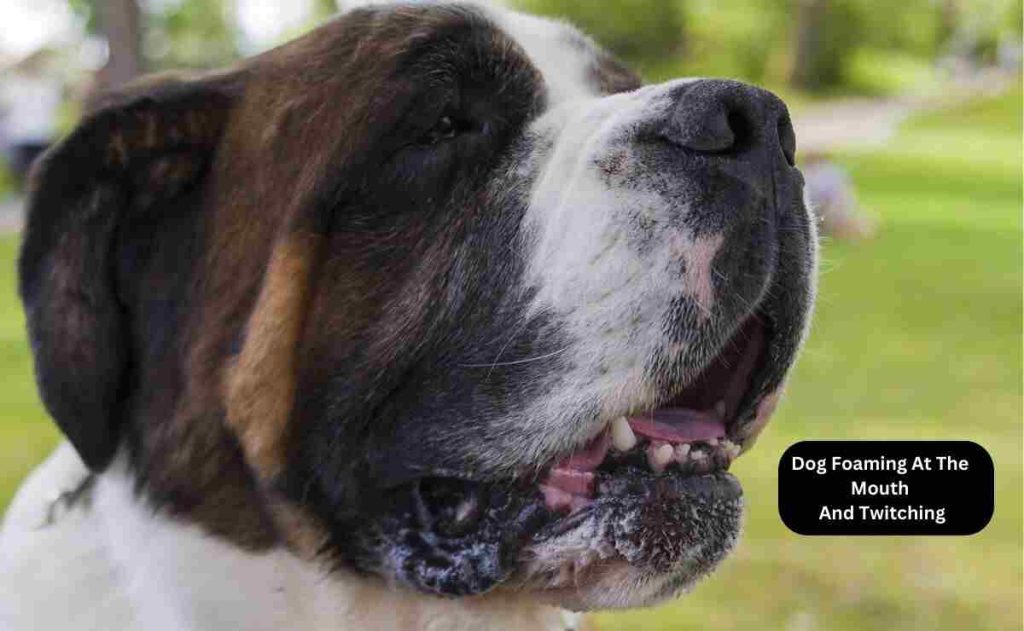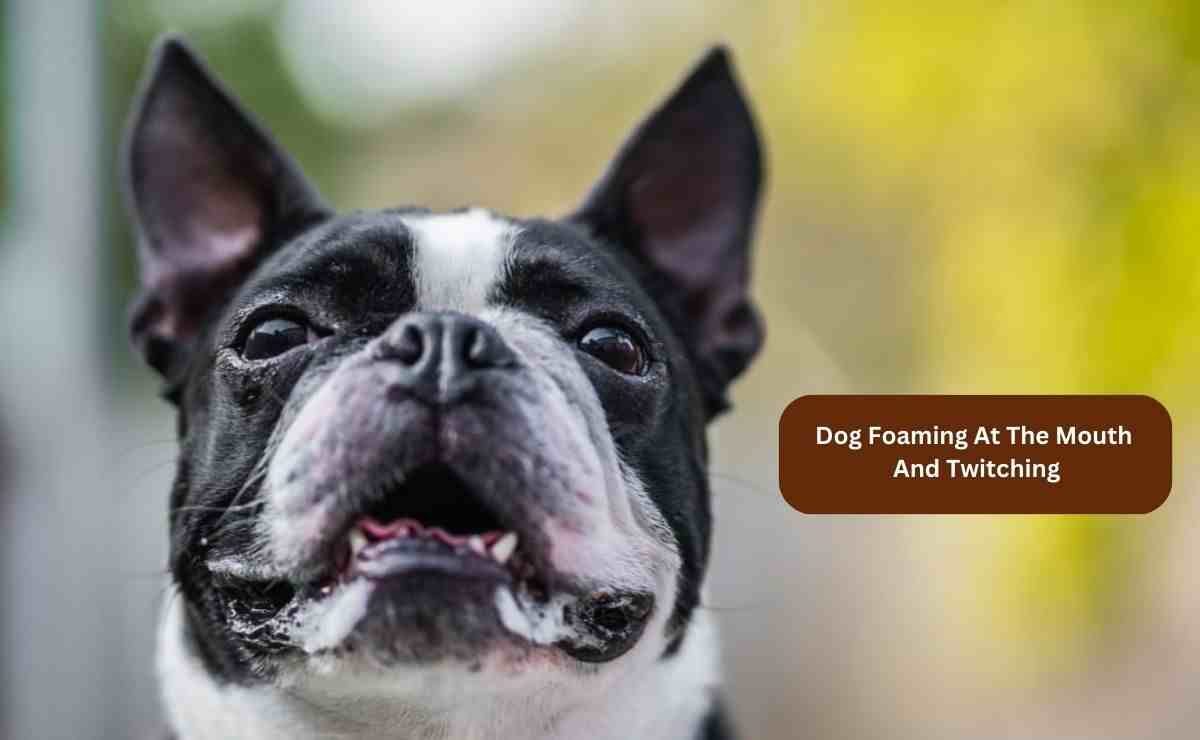It’s a frightening sight when you notice something unpleasant with your furry friend. Often pet parents rush to the vet asking why is my dog foaming at the mouth and twitching. Is it really a big concern?
Well, there are several reasons for foaming at the dog’s mouth. It can be a call for an emergency or just a bad day. By the way, you need to monitor closely other behaviors. Identifying the signs helps a lot in resolving the problem.
What Does a Dog Foaming at the Mouth Mean?
Dog foaming at the mouth means bubbles or froth appearing on their lips, often extending around their mouth area and even out of their nose. This foam can take on the appearance of simple bubbles within the dog’s mouth.
The color of the foam is typically white or clear. Its thickness may vary as it depends on the amount of saliva of your dog’s body. Excessive salivation is a common factor, and this may manifest as your dog drooling more than usual.
The increased saliva production can be a result of irritation from something happening inside your dog’s body. It’s important to recognize that when a lot of saliva builds up in your dog’s mouth cavity, it can lead to both foaming and excessive drooling.
In such situations, you should closely monitor your dog’s behavior for any additional signs of distress. If the foaming continues with other concerning behaviors then seek a veterian advise.
What’s The Difference Between Dog Foaming and Dog Drooling?
Drooling is a completely normal canine behavior that occurs for various reasons. It’s something that all dogs do, and there’s no need to panic if your dog starts drooling.
When they are excited, nervous, or anxious, dogs often drool. You might observe protracted saliva strands dangling from the corners of their mouth or a teardrop at the mouth’s edge. In most cases, drooling is a natural response to emotional stimuli.
Foaming, on the other hand, is not as common as drooling and may indicate an underlying issue. It is a signal of various problems, such as an allergic reaction, an infection, or even poisoning.
This behavior might be accompanied by additional signs like head shaking, rubbing the face on the ground, and pawing at the face. If you notice shaking and twitching, it could be a sign of a seizure.
While drooling is a part of a dog’s everyday life and is typically harmless, foaming can be a red flag indicating an underlying issue. If your dog is exhibiting foaming along with twitching, it’s essential to go to a vet.
Why Is My Dog Foaming At The Mouth And Twitching?

If your dog is foaming at the mouth and twitching at the same time, it is an alarming situation. There are various reasons behind it like
1. Seizure
Seizures in dogs are a complex neurological phenomenon. It’s an uncontrolled electrical disturbance in the brain. This abnormal brain activity leads to significant changes in behavior and primarily affects the head, neck, and legs. It leads to noticeable twitching and jerking movements.
During a seizure, a dog experiences a complete loss of control over their body, they don’t breathe properly, etc. The duration of a seizure can vary widely from one dog to another. While some seizures last only a few seconds, others can extend for several minutes. It can be cured with medications prescribed by a veterinarian.
2. Gastrointestinal issues
Gastrointestinal issues in dogs can arise when they ingest inappropriate items. Dogs are curious creatures, and their mouths can lead to the ingestion of items they shouldn’t. When a dog ingests foreign objects, there is a genuine risk of these items becoming lodged in the gastrointestinal tract.
While some items may pass through the digestive system in a day or two without causing harm, others present a more serious threat, such as rope toys, puppy pads etc.
These items have the potential to create obstructions inside the dog’s digestive system. This can result in excessive saliva production and foaming, indicating the dog’s distress.
3. Digest something toxic or poisonous
Dogs can ingest items due to their curious nature. But they are harmful to their health. Most common is consuming chocolate, a Reese’s cup, or household cleaning products like Lysol.
If your dog ingests these types of toxic substances, they can have foaming at the mouth. This is a physiological response that is triggered when the body attempts to expel the poison. It causes excessive saliva production and is coupled with foaming.
Toxic substances can wreak havoc on multiple physiological systems, including the nervous, cardiovascular, and respiratory systems. The severity of the impact depends on the type and quantity of the ingested toxin. In this case, you need to immediately consult a veterian.
4. Heat Stroke
Heat stress is an early warning sign of the impending threat of heat stroke or exhaustion in dogs. When a dog experiences a surge in body temperature, panting becomes the instinctive response to dissipate heat.
However, if the dog is unable to adequately expel excess heat, as may happen during vigorous play in hot weather, the body resorts to additional cooling mechanisms, including sweating.
This causes excessive drooling and foaming at the mouth. This is a result of the dog’s attempt to regulate body temperature by increasing saliva production.
Flat-faced dog breeds, such as French Bulldogs, Pugs, and English Bulldogs, face a heightened susceptibility to heat exhaustion. The anatomical structure of their respiratory systems makes it challenging for them to efficiently cool themselves through panting.
If you suspect heat stroke, move your dog to a cool place, provide water to drink, and wet their coat with water. Seek immediate veterinary attention.
5. Rabies
Rabies in dogs is relatively rare, thanks to widespread vaccination efforts. While foaming at the mouth can be a symptom, various other conditions can also contribute to this behavior.
The central nervous system is the main target of the infectious viral disease rabies. This virus has the potential to infect the brain and spinal cord of mammals, posing a threat to both animals and humans. If left untreated, rabies can be fatal.
A dog with rabies may exhibit a range of symptoms, including:
- Lethargy
- Excessive drooling
- Difficulty swallowing and walking
- Aggressive behavior toward other animals and humans
- Foaming at the mouth
Vaccination stands as a highly effective preventive measure against rabies. If there’s any suspicion, you need to seek immediate veterinary attention.
6. Ingested something foul-tasting
Dogs can foam at the mouth if they consume something unpleasant. This could be an herb, plant, or any substance that induces a strong reaction. Fortunately, in most cases, this is a temporary issue that resolves on its own if the dog doesn’t persistently ingest the offending substance.
7. Dental Problems
Foaming at the mouth is also linked to dental issues. Dogs with dental disease can experience pain and discomfort while chewing and it leads to a reluctance to eat. Tartar buildup on teeth can exacerbate the problem. Proper dental care is crucial to prevent the issue.
8. Allergies
Some dogs have allergies that manifest as excess saliva production, vomiting, or diarrhea. When these symptoms occur during or after eating, you can notice foaming at the mouth.
In dogs who suffer from allergies, identifying and avoiding allergens in the diet is vital, and a change in food or a controlled diet may be required.
9. Stress and Anxiety
Stressful situations can trigger a mix of panting, whining, and barking in dogs. The resulting excessive drooling may escalate into frothy, foamy drool. Recognizing stressors and providing a calming environment is essential for a dog’s mental well-being.
10. Nausea and Vomiting
Foaming at the mouth can cause nausea and vomiting in dogs. If a dog experiences motion sickness or ingests something that induces vomiting, you can see the foaming at their mouth.
If you notice other persistent symptoms, such as a loss of appetite or lethargy, then a veterinary examination is necessary to find out underlying health concerns.
Conclusion
Foaming at the mouth and twitching are alarming for pet owners. It happens when something is wrong with your dog’s body. As a responsible pet owner, you should notice the potential causes and seek a thorough examination.
While some instances of foaming at the mouth can be temporary. Minor issues often resolve on their own. But you need to keep a close eye on your dog’s behavior over the next few hours. If the foaming persists or if there’s a noticeable change in behavior, you have to consult a vet immediately.
